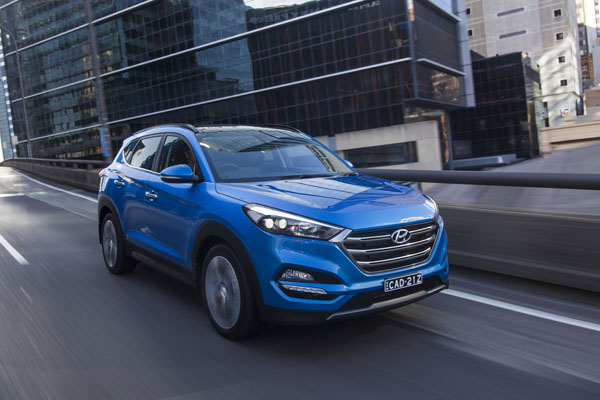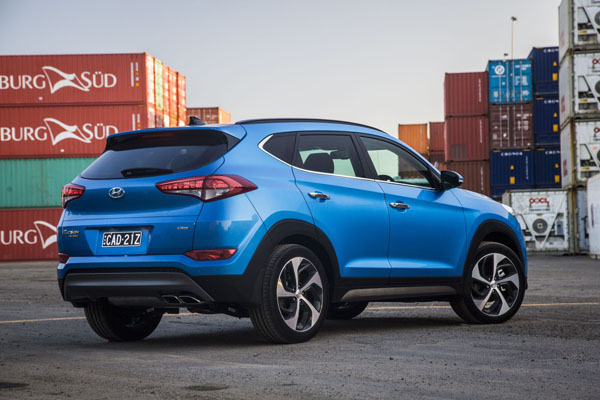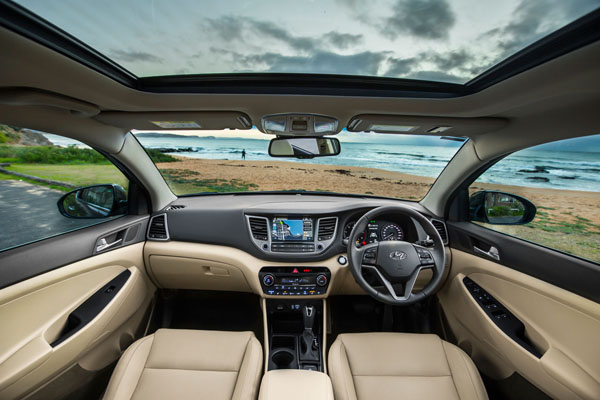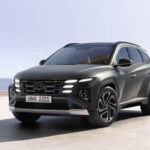
As things go, it is likely SUVs could become the biggest selling segment in the passenger car market sometime during 2016. According to industry analyst VFacts research has shown that only five per cent of four-wheel-drive owners do any serious off-roading in their vehicles. However, they favoured the high-set seating position and the robust character of the bodywork made them feel protected inside an SUV.
Automobile makers took note. They cut out the low mode of the 4×4 transfer case, leaving the vehicle, at first known as a soft-roader, able to handle bitumen and minor off-road situations such as gravel.
Since then, some have even eschewed driving all four wheels and rely on front-wheel drive only to put power to ground. The result is greater economy and a significantly lower price.
The charge has been led by small and medium SUVs. The latter segment has just been boosted by the addition of the Hyundai Tucson, a reworking of the popular Hyundai ix35, moving it up into the larger group.
The four-tier Tucson range offers front-wheel drive or all-wheel drive, four engines and three transmissions. I had a taste of the ActiveX two-wheel drive variant, which comes to market at $32,990, plus on-road costs.
STYLING
In design terms, the Tucson is the poster boy for Hyundai, setting the design trend taken up by its big brother, the Santa Fe Series II, the top-selling i30, Sonata sedans and the upmarket luxury Genesis.
Daytime running lights and foglamps are set in separate angular bumper-height recesses. Side body lines sweep upward and asymmetric wheel arches wrap new-design 17, 18 or 19-inch alloy wheels.
The rear design is kept simple with horizontal lines flowing from bold rear wheel arches and accentuated by slim combination tail-lights. Slim reflectors are integrated into the rear bumper. It all adds up to an impressive drag coefficient for this class of 0.33 Cd.
INTERIOR
Longer, taller and with wider track than the ix35 it replaces, the Hyundai Tucson weighs in with a bolder stance, more front and rear leg and hip room, and more cargo space (488 litres) with the rear seats in place.
A new wider tailgate allows easier access to the bigger luggage area. Maximum opening width has been increased to 1094 mm, up from 1080 mm.
A result of ‘California Dreaming’ from the US design centre, the cabin has been given a more sophisticated and user friendly surroundings. The modern dashboard has a 7.0-inch infotainment screen and contrasting black dash surfaces, and air vent and centre console chrome accents.
Chasing a boost in quality, re-engineered door mechanisms produce a softer sound when they are opened and shut with a deeper, more solid tone, while dust-sealing testing, performed in the Australian outback, produced outstanding results, says Hyundai.
INFOTAINMENT
In a first for Hyundai the Tucson ActiveX features Apple CarPlay, with Android Auto to follow early next year. Both systems offer seamless integration with smartphones to provide safe access to Google Map or Apple Map navigation, Siri or Google Voice command, including hands-free messaging and dictation, music, calendar entries, apps and more.
Google Android Auto connectivity will soon also be possible via software updates. ActiveX is equipped with a 7.0-inch touchscreen infotainment system with MP3 capability and six speakers.
ENGINES / TRANSMISSIONS
Hyundai’s 2.0-litre direct-injection four-cylinder petrol engine is available exclusively in 2WD Tucson ActiveX, combined with Hyundai’s advanced six-speed automatic transmission.
SAFETY
A more rigid body than in the ix35 and improved structures to absorb crash forces are key factors in a high level of passive safety. This is complemented by six airbags – driver and front passenger airbags, front side (thorax) airbags and full-length curtain airbags.
Three-point seatbelts are fitted at all seating positions. The driver and front passenger seatbelts incorporate anchor-point pre-tensioners and crash-locking tongues in the buckles.
Active safety features include Hyundai’s Electronic Stability Control system, reversing camera with dynamic steering guidelines, four-sensor rear parking assist, automatic dusk-sensing headlights and LED high-mount stop light and daytime running lights. Tucson’s brakes have been improved across the range.
DRIVING
The new Tucson’s increased cabin space is worthy of its upgrade to medium SUV status, while mobility and manoeuvrability are in keeping with a compact vehicle.
The engine / transmission package is efficient, quiet and friendly, leading to stress-free motoring, although, without all-wheel drive, there is a hint of understeer when pushed on bends.
We recorded fuel consumption of 7.9 litres per hundred kilometres during a mixture of town and country driving.
Improved isolation of key components and increased use of sound-deadening materials in such areas as behind the dashboard, inside wheel arches and over a larger area of the drive tunnel contributed to better NVH. The stiffer body structure also helped reduce road noise inside the cabin.
Good steering response comes from Tucson’s electric power steering (EPS) using the latest Logic computer processing.
The new Tucson adopts Hyundai’s latest Drive Mode Select system, as used in new Sonata and Genesis. ActiveX features two settings, each adjusting transmission programming, throttle mapping and steering effort. In Eco, throttle effort is increased and, to help conserve fuel, transmission upshifts arrive at lower revs.
As with all Australian Hyundai cars and SUVs, Tucson’s suspension was exhaustively tested in local conditions and tuned for Australian roads by the company’s local chassis development team.
SUMMING UP
Setting aside the fact that the Hyundai Tucson ActiveX makes do with front-wheel drive as opposed to all-wheel power distribution, it is worthy of its medium-size SUV upgrade through space, and quality and range of specification. A bonus is the attractive purchase price and Hyundai’s five-year, unlimited kilometre warranty and Hyundai iCare.
AT A GLANCE
MODEL LINE-UP
Tucson Active 2MPi 2WD: $27,990 (manual), $30,490 (automatic)
Tucson Elite 2MPi 2WD: $35,240 (automatic)
Tucson ActiveX 2GDi 6sp manual 2WD $30,490 (manual), $32,990 (automatic)
Tucson Elite 1.6 T-GDi AWD: $38,240 (automatic)
Tucson Highlander 1.6 T-GDi: AWD $43,490
Tucson Elite 2.0 CRDi AWD: $40,240 (automatic)
Tucson Highlander 2.0 CRDi AWD: $45,490 (automatic)
Note: These prices do not include dealer or government charges. Contact your local Hyundai dealer for drive-away prices.
FEATURES
18in alloy wheels with 225/55R18 tyres
Six airbags (driver & front passenger, driver & front passenger side (thorax), full length curtains)
Electronic Stability Control
Rear view camera
Rear parking assist system
LED Daytime Running Lamps
Projector beam headlamps with escort and welcome function
Automatic dusk sensing headlamps
Front Fog Lamps
Leather appointed seats
Premium steering wheel & gear knob
7in touchscreen audio, MP3 capability, 6 speakers. Apple CarPlay and Android Auto (early 2016)
Steering wheel mounted audio controls
Electric folding / heated side mirrors
Cruise control with steering wheel mounted controls
Roof Rails
SPECIFICATIONS:
(2.0-litre four-cylinder petrol engine)
Capacity: 1999 cc
Configuration: Four-cylinder, inline, 16-valve, front-mounted, transverse
Bore and stroke: 81 mm x 97 mm
Compression ratio: 11.5:1
Maximum Power: 121 kW @ 6200 rpm
Maximum Torque: 203 Nm @ 4700 rpm
Emission rating: Euro 5
DRIVELINE:
Drivetrain: 6sp manual / 6sp automatic. front-wheel drive
DIMENSIONS, WEIGHT AND CAPACITIES:
Length: 4475 mm
Width: 1850 mm
Height: 1655 mm
Wheelbase: 2670 mm
Track: 1608 mm (front); 1620 mm (rear)
Ground clearance: 172 mm
Gross vehicle mass: 2070 kg / 2090 kg
Kerb weight: 1569 kg / 1584 kg
Towing capacity: 1600 kg (braked) / 750 kg (unbraked)
Tow ball download: 120 kg
Seating capacity: 5
Cargo capacity 488 litres / 1478 litres
Fuel Tank Capacity: 62 litres
Turning circle: 10.6 m
SUSPENSION AND BRAKES:
Suspension: McPherson strut (front); Multilink (rear)
Brakes: Ventilated discs (front); solid discs (rear). Dual–diagonal, split circuit, power assisted with Electronic Brake force Distribution, Brake Assist. Vehicle Stability Management, Traction Control, Hill Start Assist
Steering: Motor driven power steering, rack and pinion
Wheels / tyres: 18in x 7.0J alloy wheels / 225/55R18. Full-size spare
PERFORMANCE
Acceleration 0 to 100 km/h: N/A
Top speed: N/A
FUEL CONSUMPTION:
Fuel type: 91 RON unleaded
Combined Cycle (ADR 81/01): 7.8 litres per 100 km / 7.9 litres per 100 km. CO2 emissions 182 g/km / 185 g/km
WARRANTY:
Five years / unlimited kilometres











